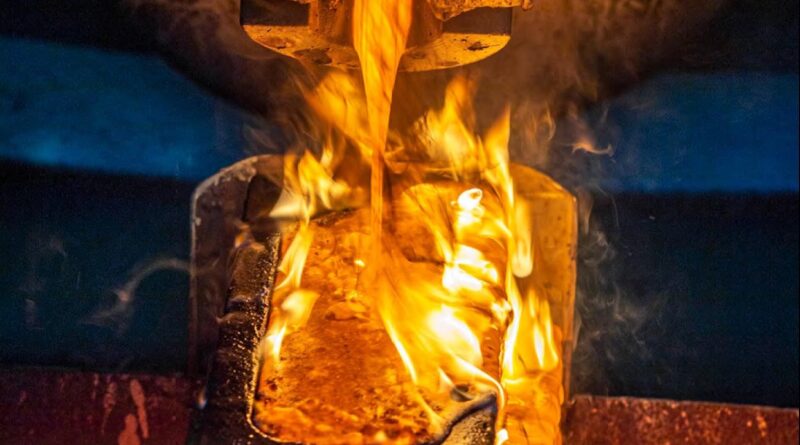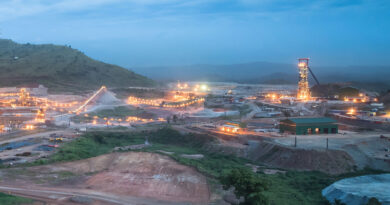AngloGold Ashanti: Africa’s gold production was 9% higher
In the Africa region, AngloGold Ashanti gold production was 397,000oz for the quarter ended 30 September 2023, compared to 443,000oz for the quarter ended 30 September 2022. Gold production was 10% lower year-on-year mainly due to lower gold production at Obuasi, Siguiri and Geita, partly offset by higher gold production at Iduapriem and Kibali.
Gold production was 9% higher quarter-on-quarter at 397,000oz in the third quarter of 2023, compared to 365,000oz in the second quarter of 2023, mainly due to higher gold production at Kibali, Geita, Iduapriem and Siguiri, partly offset by lower gold production at Obuasi.
In Ghana, at Iduapriem, gold production was 71,000oz for the quarter ended 30 September 2023, compared to 66,000oz for the quarter ended 30 September 2022. Gold production was 8% higher year-on-year mainly due to higher overall recovered grades compared to the
prior period as the mine accelerated the mining in Block 7 and 8 Cut 2 A and B, as well as an increase in processing plant throughput on the back of the commissioning of the new TSF.
Gold production at Iduapriem was 27% higher quarter-on-quarter at 71,000oz in the third quarter of 2023, compared to 56,000oz in the second quarter of 2023, mainly due to higher ore tonnes processed and higher overall recovered grades.
At Obuasi, gold production was 46,000oz for the quarter ended 30 September 2023, compared to 72,000oz for the quarter ended 30 September 2022. Gold production was 36% lower year-on-year mainly due to lower underground ore tonnes processed and lower overall recovered grades.
Gold production at Obuasi was 19% lower quarter-on-quarter at 46,000oz in the third quarter of 2023, compared to 57,000oz in the second of 2023, mainly due to lower underground ore tonnes processed and lower overall recovered grades.
Production was negatively impacted by poor ground conditions within some of the higher-grade stopes. During August we lost some underground mining equipment as a result of a fall-of-ground incident in one of the mine’s high-grade stopes. Although nobody was injured in the incident, the decision was taken to proceed more slowly to ensure safety of our operators.
During the month of October we have begun using significantly larger drilling equipment (the V30 reamer) to establish new stopes, which in turn is allowing us to safely increase production and reach similar levels of production to those achieved last year. Going forward, Obuasi isalso pursuing a change in mining approach in high-grade areas to a more selective method suitable for difficult ground conditions and higher-grade ores (underhand cut and fill). The transition to this new method in higher-grade areas is expected to take place throughout 2024 following an initial trial period. As a result of the change in mining method, Obuasi is now forecast to produce at levels similar to last year in 2023, and close to 300,000oz in 2024, as it continues its ramp-up.
In Tanzania, at Geita, gold production was 126,000oz for the quarter ended 30 September 2023, compared to 156,000oz for the quarter ended 30 September 2022. Gold production was 19% lower year-on-year mainly due to a combination of lower ore tonnes processed and lower overall recovered grades. Geita remains on track to achieve its 500,000oz gold production target for 2023.
Gold production at Geita was 6% higher quarter-on-quarter at 126,000oz in the third quarter of 2023, compared to 119,000oz in the second quarter of 2023, mainly due to higher ore tonnes processed and higher overall recovered grades.
In the Republic of Guinea, at Siguiri, gold production was 55,000oz for the quarter ended 30 September 2023, compared to 66,000oz for the quarter ended 30 September 2022. Gold production was 17% lower year-on-year mainly due to lower feed grades in the different areas mined, and the CIL tank failure during the second quarter of 2023. Gold production was further adversely impacted by community protests at some of the open pits in relation to additional employment opportunities. These protests have since subsided.
Gold production at Siguiri recovered strongly quarter-on-quarter, rising from 45,000oz in the second quarter of 2023 to 55,000oz in the third quarter of 2023, following the restoration of processing capacity. Gold production was 22% higher quarter-on-quarter mainly due to higher ore tonnes processed, partly offset by lower overall recovered grades. It is expected that recovery rates will improve by the end of this year, as the remaining CIL tanks are re-commissioned and reintroduced into the processing circuit.
In the DRC, at Kibali, gold production was 99,000oz for the quarter ended 30 September 2023, compared to 83,000oz for the quarter ended 30 September 2022. Gold production was 19% higher year-on-year mainly due to higher ore tonnes processed and higher overall recovered grades.
Gold production at Kibali was 13% higher quarter-on-quarter at 99,000oz in the third quarter of 2023, compared to 88,000oz in the second quarter of 2023, mainly due to higher ore tonnes processed and higher overall recovered grades.
GUIDANCE
The Company previously provided guidance for 2023, which remains unchanged. The Company remains on track to achieve full year gold production guidance. Gold production is expected to be second half weighted, with fourth quarter gold production expected to be the strongest out of all the quarters this year.




